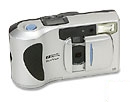HP Photosmart 315 Digital
Camera Review
 With the ever growing popularity of digital cameras it's no
surprise that this market has not only attracted traditional photography giants
such as Kodak or Olympus, but also has brought forth competition in the form of
devices from such consumer electronics manufacturers such as Sony and
Toshiba.
With the ever growing popularity of digital cameras it's no
surprise that this market has not only attracted traditional photography giants
such as Kodak or Olympus, but also has brought forth competition in the form of
devices from such consumer electronics manufacturers such as Sony and
Toshiba.
One of the reasons for this can be
attributed to the fact that such companies are used to producing various
electronic devices, and as such, are well able to produce solid digital cameras.
One manufacturer in particular however, clearly has the potential to make an
excellent digicam, as they have a strong background in digital imagery. With a
long history is selling top quality printers and scanners, it's no surprise that
Hewlett Packard has chosen to adopt digital cameras as a major product line for
themselves.
As a company who has been in the digital camera market for a
few years now, HP has recently refreshed their camera lineup to include the
Photosmart 215, 315, 618, and 912. The Photosmart 215 and 315 cameras are
catered towards families and other general purpose users, while the 618 and 912
are aimed at the "prosumer" class (those who don't quite need a high quality
(and high priced) digital SLR camera, but need a more versatile camera than what
a basic unit offers).
You may notice that these cameras share the same
name as HP's highly regarded Photosmart printers. This is definitely by no means
a mere coincidence, as the cameras and printers are designed to work together to
facilitate both the input and output of digital images. Photosmart printers, for
example, are able to accept Compact flash memory cards from Photosmart cameras
(as well as other digicams), and print wirelessly from the new Photosmart
cameras via infrared.
Today, we'll be taking a look at the Photosmart 315
unit in particular, which boasts a native resolution of 2.1 megapixels, and an
amazing suggested price of $299 (US). These two features alone have been
virtually unheard of until now, as most cameras priced around $300 offer only
1.3 megapixels or less.
Features and
Specifications
| · |
Resolution: 2.1
Megapixels |
| · |
Exposure Rating: ISO
100 |
| · |
Shutter Speed: 1/750 to 2
sec |
| · |
Lens system: 5 element glass
lens; f/2.8; TTL auto focus; 5.8 mm (38 mm equivalent) |
| · |
Connectivity, Std: USB to PC or
Mac; HP Jetsend Infrared; Standard tripod mount |
| · |
Power Supply: 4 AA batteries
(included) or optional AC adapter |
| · |
Timer: 10 sec
delay |
| · |
Memory Interface: Compact
Flash |
| · |
Zoom Type:
Digital |
| · |
Zoom Range: 1.0 2.5x in 0.5x
increments |
| · |
Weight: 8 oz without
batteries |
| · |
Minimum System Requirements:
Windows 98, 2000 Professional, Me, NT 4.0, 133 MHz Pentium processor or
better, 32 MB RAM, 800 x 600; 16 bit color display |
| · |
Dimensions: (W x D x H) 5 x 2.7
x 1.3 in |
A quick glance at the specifications for this camera shows
that aside from the aforementioned 2.1 megapixel resolution, there are a few
other notable enhancements made to the camera. For one, HP uses USB to transfer
images from the camera to a PC or Macintosh. Considering 2.1 megapixel images
are fairly large, opting for USB was a wise decision. As we'll see later on, USB
enables this camera to download images very quickly, despite their large file
sizes.
Other than that, the camera bundle is fairly plain. No AC adapter
is included (though one is available from HP's website at a suggested price of
$49.99). While this may be cause for concern, do take note that this camera uses
standard AA batteries, which can be replaced easily when drained.
Perhaps
the greatest cost cutting measure used with this camera would be its limited
zoom capabilities. Offering no optical zoom (the preferred method of zooming, as
it maintains full image quality), the camera instead relies on a 2.5x digital
zoom capability. Take note however, as HP is definitely not alone in this
regard. With only a few exceptions, most cameras priced around $300 lack this
same ability. Even still, if HP had been able to cram an optical zoom lens into
the unit, while maintaining it's already low price, it would have been icing on
the cake.

